Fertilizer is an important part of any gardening or landscaping project, but it can be confusing to know which type to use. Slow-release fertilizer is a popular choice because it provides a long-lasting source of nutrients for plants. However, fast-release fertilizer can also be effective, and it has some advantages over slow-release products. So, what’s the difference between these two types of fertilizer, and which one is better?
Slow-release fertilizer is released into the soil slowly over time, typically over the course of several months. This means that plants have a steady supply of nutrients, which can help them to grow more evenly. Slow-release fertilizer is also less likely to wash away in heavy rains or be taken up by weeds. On the other hand, fast-release fertilizer is released into the soil quickly, providing a sudden boost of nutrients. While this can sometimes be helpful for giving plants a quick shot of energy, it can also lead to nutrient overload, which can damage plants. In general, slow-release fertilizer is a better choice for most gardening and landscaping projects. However, fast-release fertilizer can be useful in certain circumstances, such as when you need to give your plants a quick boost of growth.
Table of Contents
Slow Vs. Fast Release Fertilizer: What’s The Difference and Which One is Better?
Your trees are the mightiest structures in your home landscape.
They provide texture, vertical structure, and color. Some add delicate flowers in the springtime, while others deliver gobs of cooling shade. Some showcase vibrant colors in autumn, while others keep your home cool during the hot summer months or block cold winter winds.
To deliver the blooms, shade, and other benefits you love, trees require regular maintenance. Providing fertilization on an annual basis can ensure trees thrive, receiving nutrients they need that may not be available in the soil.
In your quest to learn about fertilizing your trees, you may have heard about slow-release fertilizer and fast-release fertilizer. You might be wondering what the differences are between the two and which one would be best for your trees.
Let’s look at the difference between slow-release and fast-release fertilizers and talk about why fertilization helps your trees so you can take better care of your favorite landscape assets.
Why You Should Fertilize Your Trees
Fertilizing trees can not only boost tree health, but it can also make your landscape look better and elevate your curb appeal.
You might think nutrients are available in the soil, but in the built environment like your suburbs that may not be the case. Trees growing in forests receive natural fertilizer with the continued recycling of fallen leaves. But, in your yard, leaves are swept away and trees often have to compete with grass for nutrients. Not to mention, the building of your home probably involved the loss of topsoil, depleting it of nutrients as well.
That’s why fertilizing your trees is so important: It helps replicate the natural fertilization process that happens when trees grow in the forest. But which one helps you come closest to the forest floor: slow vs. fast-release fertilizer?
What is the Difference Between Slow-Release Fertilizer and Fast-Release Fertilizer
You’re probably wondering what the key differences are between slow-release fertilizer vs. fast-release.
Simply put, fast-release fertilizer dissolves very quickly in your soil, making those nutrients instantly available to the tree. In contrast, slow-release fertilizers will release small, steady amounts of nutrients over an extended period of time.
Is Slow-Release Fertilizer Better Than Fast Release?
Fast-release fertilizers have their purpose. They are readily available for trees to take up. But the big challenge is that they must be properly placed using precise timing. They have their uses but require professional knowledge of how they work, the tree species and condition, as well as proper training in application timing and techniques.
Slow-release fertilizers, on the other hand, involve a slow-release rate of nutrients that are released over time based on soil temperature, moisture, and conditions. This extends the fertilizer’s benefit by making it available to your tree longer.
Fast-release fertilizers have a higher salt index than slow-release fertilizers, which means they can burn plants if applied too heavily in one spot. Slow-release fertilizers are very unlikely to ever burn plants. Slow-release fertilizers will also be less likely to contribute to any harmful effects on pest and disease damage exacerbated by over-fertilization.
When to Apply Slow-Release Fertilizer
One of the perks of slow-release fertilizer is that you don’t have to worry about optimum timing. Since it slowly releases nutrients over time, precise timing isn’t necessary.
But there are still some general benefits of timing to follow with slow-release fertilizer timing. You never want to apply it when the soil is frozen. And certain seasons are also beneficial for nutrient applications. In the fall, you can help your tree recover nutrients from the soil lost in summer. In spring, you can support new growth and provide the tree with nutrients that keep it healthy and enable it to grow a full, green canopy.
How Long Does it Take for a Slow-Release Fertilizer to Work?
There are quite a few slow-release fertilizers available. To understand how long they take to work, ask your certified arborist for answers and recommendations.
Davey professional certified arborists prefer using Arbor Green PRO in Northern and Western parts of the country and Arbor Green Xtra plus B in the South. They consider these products the best slow-release fertilizers for trees and shrubs.
To understand which slow-release fertilizer is right for your trees, obtain guidance from your local arborist, who will conduct a soil test and find out what your trees need. This is the best way to take care of your trees and keep them growing strong.

